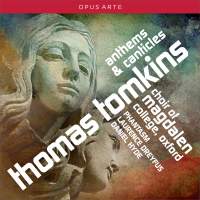Reviewer: William
J. Gatens
Thomas Tomkins (1572-1656) was
born to a family of church musicians in St Davids, Wales. His father was
organist of the cathedral there, and while very little is known of the early
life and musical training of the younger Tomkins, it seems certain that he
was a chorister at St Davids. The family moved to Gloucester in 1594 where the elder
Tomkins was appointed minor canon and later precentor of the cathedral. The
younger Tomkins may at some time have been a pupil of William Byrd. By 1620
he was a Gentleman of the Chapel Royal and was for the greater part of his
career organist of Worcester Cathedral. As his dates indicate, he suffered
under the suppression of cathedral music during the Commonwealth, though he remained nominally
the cathedral organist and resided in the cathedral close for the rest of
his life.
The five verse anthems on this recording and the evening canticles
of the Fifth Service survive with accompaniment for viol consort. As Daniel
Hyde points out in his notes to the choral works, it is a genre that has
stylistic links with the consort song and probably originated in the
Elizabethan Chapel Royal. Laurence Dreyfus observes in his notes
on the consort music that Tomkins wrote for viol ensemble over the whole course
of his long career. The pieces included here “sample some of his most
striking compositions for three to six viols” that “stamp the composer’s
personal imprint on the consort style”. Three of the pieces are fantasias,
and the rest are in dance forms: pavan, alman, and galliard. The intense
chromatic writing of the six-part Fantasia 17 may remind listeners of
Gesualdo. The six-part Pavan & Galliard 18 is notable for a restless
oscillation between major and minor. Daniel Hyde completes the program with
three of Tomkins’s organ pieces.
Elsewhere in this issue (see Dowland) I have expressed my
admiration for the artistry of Laurence Dreyfus and his viol consort,
Phantasm. Better consort playing can hardly be imagined. The choir of
Magdalen College, Oxford is one of the outstanding traditional English
choral foundations, and their performances here can hardly be faulted on
technical grounds. Sometimes the solo voices in the verse anthems are hard
to hear against the background of the viols, but the ear adjusts.
There are not very many recordings devoted entirely to the works
of Tomkins. Some that have come to my attention may have much to recommend
them, yet tend to be less than warm and engaging. One exception is a
recording by an ensemble of six outstanding early music soloists and the
viol consort Fretwork (Harmonia Mundi 907320;
Sept/Oct 2003). The anthems are the same as on the present recording, but
with a flavor of domestic chamber music. The contrast is quite striking.
Fermer la fenêtre/Close window
|




